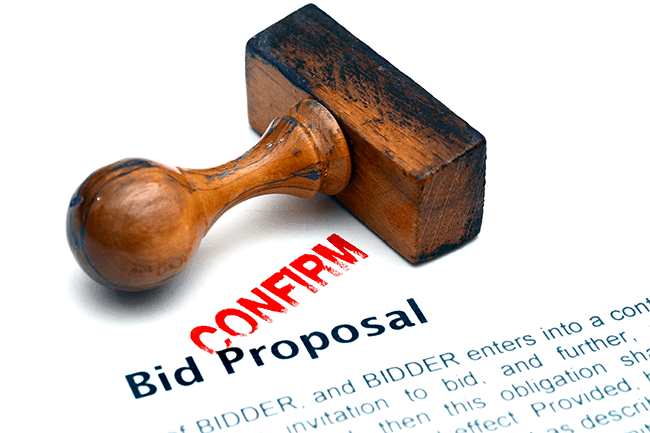
WHAT IS AN RFP | 20 MIN READ
One thing we know for sure is that crafting a quality Request for Proposal (RFP) is not an easy task and can take significant time to get it right. As a leader in the copier and printer industry, Standard Office Systems is here to offer this blog to help you, especially if you are writing one for a copier or multifunction device.
As a Vice President of Sales for an industry-leading copier and office technology dealer in the United States and winner of multiple RFP's, I will give examples on how to put together the best RFP for your organization that is specific to office technology, but the lessons learned are directly transferable to anyone drafting an RFP.
You may be new to your role or perhaps you haven't written a Request for Proposal (RFP) in a while and need a refresher. As a company who receives these requests from organizations often, we have the unique pleasure of seeing a variety of styles and levels of detail in the RFP's we receive.
Sometimes, the RFP's we receive leave out important considerations that should be requested to ensure organizations are getting the best value possible for the product or service they are requesting. This causes RFP's to be dramatically different and can create an "apples to oranges" scenario that creates an impossible decision.
This blog will help you understand what an RFP are as well as what to consider when writing one, and most importantly, how to write one. There's nothing worse than going through all of the trouble to create an RFP that gives plenty of detail in making sure you will get related and comparable bids, only to have pieces missing here and there from each Respondent.
If you've ever experienced the above scenario, let me encourage you to look inward. Sometimes, it's because the Respondent is not paying close enough attention. Other times, it is because the RFP wasn't clear or was missing valuable details that would have led to better bids.
Not a lot of time? Skip to what you need:
How to Write a Great Copier RFP
What is an RFP?
An RFP [Request for Proposal] is used by businesses and organizations to request products or services from vendors in a uniform manner to ensure that an equal comparison can be evaluated.
These requests are popular within larger companies and government organizations - ex: school systems and county agencies - in the form of bid requests.
The intent of an RFP is to ensure that the organization has the opportunity to receive the best value for a service or product, while protecting them from variations in the proposal that could create extreme differences between Respondents, making it difficult (if not impossible) to choose.
Unfortunately, many companies and organizations forget important requests in their RFP's that allow for extreme variants from Respondents that muddies the bidding process.
A Note About Copier Service

The basic functions of a copier (copy, print, scan, fax) are similar in quality from machine to machine compared to where they were when Xerox first came on the scene. So, if you're only looking for a machine with basic functions, how do you decide?
Well, price is one way to do it, but as you will discover, the price can even vary between multiple vendors offering the same brand. What causes this price fluctuation?
Service.
That's right, a great machine with poor service becomes a mediocre machine fairly quickly. It doesn't matter how reliable your machine is if during the time that it does break down you're waiting for over a week to get it serviced by your vendor.
"Well, I'll just cut out the middle man because a manufacturer should be able to offer the best service! After all, they built the machine, so they must know how to fix it the best?" (Customer thought process)
That makes sense, but what many people forget about is that manufacturers train their service technicians in the same programs as that of the independent dealers. And it goes much deeper than that, but I won't sidetrack in this article. You can read all about it in our blog about the differences between copier dealers and manufacturers.
If you're ready to purchase a copier, but you aren't sure what questions you should ask your dealer, take a look at our blog about the questions you should ask a copier dealer and check out the video. You'll be ready to go in no time!
"The bitterness of poor quality remains long after the sweetness of low price is forgotten." - Benjamin Franklin
RELATED: How Much Does It Cost to Lease a Copier in 2020?
How to Write a Great Copier RFP
By following the examples of a strong RFP outlined below, you can eliminate the back-and-forth that is often associated with an RFP that does not include everything that needs to be listed and most importantly choose the right Respondent with the greatest value.
Consider the following to ensure a strong RFP:
1. Introduction
4. Standard Terms and Conditions
6. Proposal Procedures and Guidelines
7. Proposal Submittal Requirements
11. Exhibits
Exhibit A: Specific Requirements
Exhibit B: Current Copiers and Locations
Reference SheetIntroduction
The introduction should be a one-page company profile requesting proposals that also illustrates an overview of what is needed within the Respondent's proposal. This should be enough information to allow vendors to know if the proposal is something they should explore further.
It can also include how many copies should be sent with the original (sealed or otherwise), late submission penalties, or other stipulations that should be stated in advance (including the right to reject all submissions).
Minimum Qualifications
It is preferred that each Respondent be registered in your state of business and should provide evidence of their registration in the state. Respondents need to submit evidence of a minimum of 5 years’ experience with similar projects.
Respondents should also submit completed E-Verify Documents, Security and Immigration Compliance Act forms and Contractor Affidavit and Agreement forms, all supplied by you.
Calendar of Events
The Calendar of Events should include an Action and a Deadline. This section of the RFP is important because it clearly lays out a timeline of deadlines that must be met so that you can complete your project on time.
Below is an example:
ACTION DEADLINE (Sample)
- Issuance of Request for Proposal (RFP) Thursday, June 4, 2020
- Submission of Question by Tuesday, June 16, 2020
- 2:00 pm EST
- Response to Questions Friday, June 19, 2020
- 5:00 pm EST
- Proposal Submission Deadline Tuesday, July 7, 2020
- 5:00 pm EST
- Evaluation Period July7 – 14, 2020
- Recommendation to the Board July 14, 2020
- Award of RFP Monday, July 20, 2020
- Begin Installation Mid-Late August 2020
Standard Terms and Conditions
How strict your terms and conditions are in your RFP will depend on how available quality vendors are in your market. The more plentiful, the more strict you can be with your terms and conditions.
In other words, more strict terms and conditions will thin out the number of vendors who will attempt to place a bid for your business. If you want to ensure you have a variety to choose from and are more willing to accept alternative solutions/terms, then consider leaving terms and conditions more open-ended.
Below is an example of terms and conditions that could be placed in a copier RFP. However, the actual terms and conditions you place will be based on the needs of your business:
Respondent shall deliver to our company all the goods and/or services described herein for the consideration set forth herein.
Delivery shall be made to the address listed on the Purchase Order or Contract and within the time specified.
Risk of loss shall remain with Respondent until acceptance by our company.
Title to the goods shall remain with Respondent until acceptance by our company.
Respondent warrants that the goods are merchantable and as described herein.
We shall have the right to inspect the goods at the time and place of delivery.
No right or interest in the contract shall be assigned by Respondent without the written permission, and no delegation of any obligation owed or of the performance of any obligation by Respondent shall be made without written permission.
The laws in our State and the policies of our company shall govern this agreement in all respects.
All goods and/or services supplied pursuant to this purchase order or contract shall, unless otherwise stated, conform exactly to all of the descriptions and attachments contained in the Request for Proposal upon which this order is based, and the terms, conditions, and specification of the Request for Proposal are incorporated herein by reference and made a part hereof.
Any goods supplied found not in accordance with the description and specifications set forth in the Item Schedule will be rejected. Goods rejected shall be returned, freight collect to the Respondent.
Prices stated are F.O.B. destination. No further allowances shall be made for freight and delivery charges.
Successful Respondent will be required to supply an original and one copy of each invoice, and to reference all invoices to the proper purchase order number. No invoice will be processed for payment until all contractual obligations have been met.
Successful Respondent must furnish proof of liability insurance as stated in the “Insurance Requirements” upon contract award. Respondent must maintain insurance coverage for duration of contract.
We reserve the right in its sole and complete discretion to reject any or all responses/proposals and to waive technicalities and informalities. We anticipate that the contract will be awarded to the most responsive and responsible Respondent who provides the proposal that is within the budget parameters for the project and whose proposal response meets the requirements and criteria set forth in this RFP.
We reserve the right to award these services in any way economically feasible or in the best interest for matching purposes.
We reserve the right to (i) reject all responses/proposals in their entirety, for any reason, (ii) award the contract to the most qualified applicant as determined solely by our company at its discretion.
We assume no responsibility or obligation to the Respondents and will make no payment for any costs associated with the preparation or submission of a proposal.
Standard terms for payment shall be Net 30 days from the date of delivery of goods or services, or date of receipt of correct invoice, whichever is later. All payments will be made in accordance with our company’s policies and procedures.
Insurance Requirements
All RFP's require insurance. This protects your company in case something were to happen beyond your company's control. For instance:
- A vendor's employee injures themselves on your property during installation
- A vendor damages your business' building (like a wall) or equipment during the installation
It's important to ensure that your organization is covered in these situations so that you are not potentially held responsible financially for something that happens on your property that is beyond your control.
Below is an example of what you could be asking for based on your organization’s needs:
-
Required Certificates
-
Commercial General Liability Insurance Policy
Respondent shall procure and maintain a Commercial General Liability Insurance Policy, including products and completed operations liability, and contractual liability coverage covering bodily injury, property damage liability and personal injury. The policy or policies must be on any “occurrence” basis unless waived by the Owner of the RFP. The policy shall include contractual liability coverage. The policy purchased by the Respondent must be issued by a company authorized to conduct business in the State of the RFP or by a company acceptable to the Owner of the RFP. The policy must include separate aggregate limits per project. Excess liability coverage may be used in combination with the base policy to obtain the limits listed below.
Limits
$1,000,000 per Person
$1,000,000 per Occurrence
-
Business Automobile Liability Insurance Policy
The Respondent shall procure and maintain a Business Automobile Policy with liability limits of not less than $1,000,000 per person and $1,000,000 per occurrence or a policy with a combined single limit of not less than $1,000,000 covering any owned, non-owned or hired autos. Excess liability coverage may be used in combination with the base policy to obtain these limits.
-
Workers’ Compensation Insurance
Workers’ Compensation Insurance in accordance with applicable state laws with the following limits:
Limits
Bodily Injury by Accident - $500,000 each accident
Bodily Injury by Disease - $500,000 each employee
Bodily Injury by Disease - $500,000 policy limit
Certificates to contain policy number, policy limits and policy expiration date of all policies issued in accordance with this contract.
Proposal Procedures and Guidelines
It is important to be very clear as to how you wish for deliverables to be presented to you. This also ensures that each vendor is getting a fair timeline and equal treatment.
This makes it much easier for a business to make a decision because it ensures vendors are playing by the same rules, thus making it easier to compare "apples to apples" so to speak.
Below is an example to use for the submission of RFP's, keeping in mind that some of the statements in the sample below may not be required for every RFP or for every industry:
The Respondent must complete and deliver the required documents in a sealed envelope (not always necessary) by 2:00 pm EST on Tuesday, July 7, 2020 to the address specified below:
A Pricing Schedule has been developed and enclosed for this RFP and must be used for submitting your proposal. Failure to adhere to this requirement may result in declaring your Proposal to be non-responsive and eliminated from further consideration.
The Respondent shall clearly mark the response envelope as Proposal RFP # and include the closing date and time. (See example below) If the response envelope is enclosed in another envelope/package for delivery, the latter should also be clearly marked with the same information.
“SEALED RFP”
ITEM: Copiers
RFP NO: #
DUE DATE: ##/##/####
TIME: ##:## (am/pm) EST
Under no circumstances will proposals be accepted if submitted by fax or email (not necessary for all RFP's and typically only included for timestamp purposes).
It is the sole responsibility of the Respondent to ensure that its proposal is delivered in accordance with the date, time and place requirements specified in this RFP. Any proposal received contrary to these requirements will be returned to the Respondent unopened. Any proposals submitted at or after the moment designated for proposal submittal will be deemed to be late and will not be accepted.
All proposals submitted become the property of our company.
An original and four (4) copies of the proposal must be submitted.
Proposal Submittal Requirements
The more information you give the Respondents, the more accurate each RFP received will be to your organization's needs, making it easier to evaluate. See the below example:
Each Proposal submission shall be submitted to our office and shall include the following documents:
- Acknowledgement of any addenda on page one
- The Proposal Instructions signed by an authorized agent of the company.
- The Terms and Conditions signed by an authorized agent of the company.
- E-Verify, Security and Immigration Compliance Act
- Contractor Affidavit and Agreement
- Subcontractor Affidavit
- Reference Sheet
- Checklist of Copier Features, Technical Specifications and Electrical Requirements
- Pricing Schedule (listed as Exhibits as necessary)
All proposals shall be received, and time stamped in our office no later than the Closing Date and Time shown on the cover page of this Request for Proposal.
Proposals are to be organized in the following tabs:
Tab 1 – All RFP Documents # 1- 7 from “Proposal Submittal Requirements”
Tab 2 – Experience
Tab 3 – Management and Financial Capabilities/Skills
Tab 4 – Services to be provided
Tab 5 – Copier Features, Technical Specifications and Electrical Requirements
Tab 6 – Proposed Timetable to include Implementation and Transition Plan
Tab 7 – Price Forms (Make sure you include your own pricing excel spreadsheets that all Respondents must use)
Tab 8 – Exceptions
Evaluation of Proposals
For your own sanity (to avoid having to answer this question later) and the fairness of all involved, it is good to include information on how proposals will be evaluated. This manages expectations and keeps the RFP process as objective as possible.
The example below demonstrates how a written statement regarding the evaluation process might look:
After the proposal opening, we will select for further consideration Respondent(s) deemed to be fully qualified and best suited among those submitting proposals based on Respondents’ responses to the information requested in this RFP.
The following criteria will be used in the evaluation process:
- Prior Experience in performing similar work (15 points)
- Management and Financial Capability (10 points)
- Quality and Reliability of Solution, Equipment and Services being offered to meet our needs (30 points)
- Quality of Implementation and Transition Plan (10 points)
- Cost of proposed Equipment and Services (35 points)
Based on the initial evaluation, we may request the selected Respondents to make oral presentations. Thereafter, we will conduct negotiations with each of the selected short-listed Respondents. Individuals representing the Respondent during negotiations shall have the authority to negotiate and contractually bind the company to a contract.
We are not required to furnish a statement of the reason(s) why a proposal was not deemed to be the most advantageous.
The final line is important to include because it keeps your organization from getting locked into a dispute if/when a vendor is unhappy that they were not the business selected to fulfill the RFP.
Presentation/Demonstration
In most cases (particularly with office technology), you want to leave yourself open for the opportunity of an actual presentation with vendors who have satisfied the initial requirements of the proposal.
This is important because it allows for more organic dialogue and gives the vendor and yourself opportunities to ask more detailed questions so that adjustments in the proposal can be made where appropriate.
For example:
If we feel Respondent's presentations or demonstrations of the Respondent’s proposed system’s features and capabilities are warranted, we will notify the appropriate Respondents. Such presentation or demonstration will be at our site at a date and time mutually agreed to between us and Respondent and will be at the Respondent’s expense.
Exhibit A: Specific Requirements
If you want the highest quality responses possible with the best options and pricing it is very important to give as much information as possible about your current fleet. You want to list all the minimum requirements.
Additionally, it is very important to identify all the equipment you have by model, quantity, location and monthly or annual volumes in both black & white and color.
It is also very important to list the accessories per device. It is a good idea to ask for some accessories to be priced separately so you can compare pricing accurately, as not every vendor is going to list the same accessories, creating wildly different overall pricing when combined.
Respondents will try to price the least expensive version of the device they are proposing so it is extremely important to include everything you want in the RFP so you can compare fairly. An example would be stating that all copiers must be able to print 11” x 17”. Now all Respondents know they must quote A3 equipment and all Respondents will be on the same page.
It is now very standard to include solutions (hardware, software, and accessories) in the copier RFP's. Be very specific about the solution you are looking for.
An example might include the following:
- Copiers must include send to e-mail function
- Copiers must include a network printing feature including storage on the device to send from the computer to a storage space that is password protected for a user
- The scanning solution shall be a part of the monthly lease payment submitted
- Memory minimum should be 256MB
- There must also be the option of adding fax capabilities to each copier
- Proposals should include the monthly lease payment for adding fax capabilities to each copier as an option
- Copiers should allow for job accounting functionality
- Functionality should include availability to track not only the count of copies made but also pages printed by all staff
- Copiers should allow the ability to set multiple department or employee codes per machine and have the capability to limit the number of copies or prints per code
- Copiers should allow for confidential printing functions
- Staff should be able to print from their computer to the device by entering their individual code when printing. These print jobs should be available to be retrieved at the device only after the staff have entered this code at the device.
Exhibit B: Current Copiers and Locations
This is one of the most important aspects of receiving the best value. If at all possible, you should include a list of all your current models, quantities and monthly or annual volumes.
By doing this you are ensuring the right models are being proposed based on your volumes. It is a good idea to ask for two options:
- A "like for like" replacement
- This is great when you feel the models you currently lease meet the needs of your organization (including uptime)
- Replacements based on volumes
- Gives your vendor the freedom to analyze your output and make machine recommendations based on your actual needs (which may create cost savings down the road)
Reference Sheet

You should ask for a minimum of 3-5 references of whom the Respondent has provided a similar scope of work.
The references should include the company, address, contact, title, phone number and e-mail. It should also list how long they have been a customer and the scope of work performed.
Choosing the Right Respondent

Ok - price should be high on the list, but is getting the lowest price really the most important thing? Consider two scenarios:
Company A chose a copier and vendor based on the lowest RFP price. On the surface, it appeared the machine met the operational needs of the proposal, but in reality, the RFP did not include enough specific information about the needs of the company for vendors to offer them a tailored solution. Ultimately, Company A ended up spending more money per month due to reduced efficiency and opportunity costs.
Company B chose a copier and vendor after a very clearly outlined RFP, making it easier for them to choose between comparable solutions that met their organization's needs. The vendor that was chosen may not have been the cheapest option, but the overall cost was still within the budget. Their copiers are operating 98.9% of the time without issue, and when there is an issue, a technician is on-site within 24 hours to get the machine back up and running. They may include additional costs within their RFP for software solutions that make the total cost higher, but create greater efficiency with your users.
Which company would you choose?
My guess is that you would choose Company B's scenario, but so many companies fall into the trap of Company A.
The most important take away from the scenarios above is that a clear RFP is the only way you can easily make a decision. Vague requests often lead to wildly different proposals, making your decision that much more challenging.
If you have further questions on how to construct a great RFP that will help meet your needs and assist in meeting company goals:
Posted by Bernie Schom

Bernie Schom is the Vice President of Sales at Standard Office Systems and has been in the copier and printer industry for over three decades.

